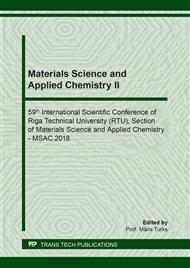[1]
V. Lempereur, S. Penavayre, Grape marc, wine lees and deposit of the must: How to manage oenological by-products? BIO Web of Conferences 3, 01011 (2014). EDP Sciences, (2014).
DOI: 10.1051/bioconf/20140301011
Google Scholar
[2]
F. Suárez-García, A. Martínez-Alonso, J.M.D. Tascón, Porous texture of activated carbons prepared by phosphoric acid activation of apple pulp, Carbon. 39 (2001) 1103-1116.
DOI: 10.1016/s0008-6223(01)00053-7
Google Scholar
[3]
M.J. Ahmed, S.K. Dhedan, Equilibrium isotherms and Kinetics modeling of methylene blue adsorption on agricultural Wastes-based activated carbons, Flui. Phas. Equil. 317 (2012) 9-14.
DOI: 10.1016/j.fluid.2011.12.026
Google Scholar
[4]
M. Berrios, M. Martin, A. Martin, Treatment of pollutants in wastewater: Adsorption of methylene blue onto olive-based activated carbon, Journal of Industrial and Engineering Chemistry. 18 (2012) 780-784.
DOI: 10.1016/j.jiec.2011.11.125
Google Scholar
[5]
A. Attia, B.S. Girgis, N.A. FathyRole, Removal of methylene blue by carbons derived from peach stones by H3PO4 activation: batch and column studies, Dyes Pigments. 76 (2008) 282-289.
DOI: 10.1016/j.dyepig.2006.08.039
Google Scholar
[6]
A.N.A. El-Hendawy, S.E. Samara, B.S. Girgis. Adsorption characteristics of activated carbons obtained from corncobs, Colloids Surf. Physicochem. Eng. Aspects. 180 (2001) 209-221.
DOI: 10.1016/s0927-7757(00)00682-8
Google Scholar
[7]
A. Namane, A. Mekarzia, K. Benrachedi, N. Belhaneche-Bensemra, A. Hellal, Determination of the adsorption capacity of activated carbon made from coffee grounds by chemical activation with ZnCl2 and H3PO4, J. Hazard. Mater. B119 (2005) 189-194.
DOI: 10.1016/j.jhazmat.2004.12.006
Google Scholar
[8]
E. Yagmur, M. Ozmak, Z. Aktas, A novel method for production of activated carbon from waste tea by chemical activation with microwave, Energy. Fuel. 87 (2008) 3278-3285.
DOI: 10.1016/j.fuel.2008.05.005
Google Scholar
[9]
O. Yunus, Kinetics of adsorption of dyes from aqueous solution using activated carbon prepared from waste apricot. J. Hazard. Mater. B 137 (2006) 1719-1728.
DOI: 10.1016/j.jhazmat.2006.05.036
Google Scholar
[10]
Q.S. Liu, T. Zheng, P. Wang, L. Guo, Preparation and characterization of activated carbon from bamboo by microwave-induced phosphoric acid activation, Ind. Crops Prod. 31 (2010) 233-238.
DOI: 10.1016/j.indcrop.2009.10.011
Google Scholar
[11]
J.A. Menendez, A. Arenillas, B. Fidalgo, Y. Fernandez, L. Zubizarreta, E.G. Calvo, J.M. Bermudez, Microwave heating processes involving carbon materials, Fuel Process. Technol. 91 (2010) 1-8.
DOI: 10.1016/j.fuproc.2009.08.021
Google Scholar
[12]
A. Ouazani, A. Iddou and A. Aziz, Biosorption of bemacid red dye by brewery waste using single and poly-parametric study, Desalin. Water Treat. 93 (2017) 171-179.
DOI: 10.5004/dwt.2017.21413
Google Scholar
[13]
M. El Haddad, A. Regti, R. Slimani and S. Lazar, Assessment of the biosorption kinetic and thermodynamic for the removal of safranin dye from aqueous solutions using calcined mussel shells, J. Ind. Eng. Chem. 20 (2014) 717-724.
DOI: 10.1016/j.jiec.2013.05.038
Google Scholar
[14]
H. Aguedal, A. Iddou, A. Aziz, A. Shishkin, J. Locs and T. Juhna, Effect of thermal regeneration of diatomite adsorbent on its efficacy for removal of dye from water, Int. J. Environ. Sci. Technol, (2018) Article in press.
DOI: 10.1007/s13762-018-1647-5
Google Scholar
[15]
M. Naderi, Surface Area: Brunauer-Emmett-Teller (BET), Prog. Filtr. Sep. (2014) 585-608.
Google Scholar


